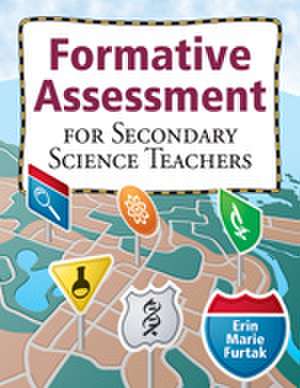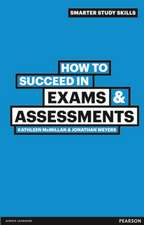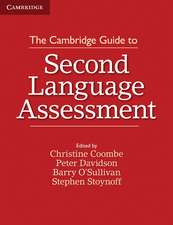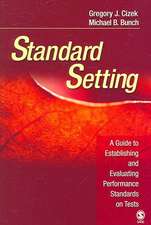Formative Assessment for Secondary Science Teachers
Editat de Erin Marie Furtaken Limba Engleză Paperback – 31 aug 2009
'This book incorporates current research and not only provides an explanation of the necessity of formative assessment, but offers a system for planning lessons and a variety of tools to implement formative assessment in the classroom' - Susan Leeds, Science Department Chair and Gifted Studies Teacher Howard Middle School, Winter Park, FL
Research has shown that when teachers use formative assessments effectively, they have a clearer understanding of what students know and are better able to design instruction that meets learners' needs.
This practical guide shows teachers how to create and implement formative assessments in their middle and high school science classrooms. Grounded in extensive and solid research, this guide covers all science content areas - physics/physical science, life science/biology, earth and space science, and chemistry - as well as five types of formative assessments: big idea questions, concept maps, evidence-to-explanation, predict-observe-explain, and multiple choice.
Teachers will find additional support in:
- Richly detailed, concrete examples of the five types of assessments
- In-depth guidelines for implementing the assessments
- Brief case studies with transcript excerpts that demonstrate how teachers have used formative assessments
- Easy-to-use templates to help analyze lessons in current units and identify places for inserting formative assessments
With this easy-to-use, hands-on guide, any teacher can learn how to use formative assessment strategies to improve student achievement in science.
| Toate formatele și edițiile | Preț | Express |
|---|---|---|
| Paperback (1) | 238.83 lei 3-5 săpt. | +19.19 lei 7-13 zile |
| SAGE Publications – 31 aug 2009 | 238.83 lei 3-5 săpt. | +19.19 lei 7-13 zile |
| Hardback (1) | 509.36 lei 6-8 săpt. | |
| SAGE Publications – 27 iul 2009 | 509.36 lei 6-8 săpt. |
Preț: 238.83 lei
Nou
Puncte Express: 358
Preț estimativ în valută:
45.70€ • 47.71$ • 37.82£
45.70€ • 47.71$ • 37.82£
Carte disponibilă
Livrare economică 14-28 martie
Livrare express 28 februarie-06 martie pentru 29.18 lei
Preluare comenzi: 021 569.72.76
Specificații
ISBN-13: 9781412972215
ISBN-10: 1412972213
Pagini: 176
Dimensiuni: 216 x 279 x 13 mm
Greutate: 0.5 kg
Ediția:New.
Editura: SAGE Publications
Colecția Corwin
Locul publicării:Thousand Oaks, United States
ISBN-10: 1412972213
Pagini: 176
Dimensiuni: 216 x 279 x 13 mm
Greutate: 0.5 kg
Ediția:New.
Editura: SAGE Publications
Colecția Corwin
Locul publicării:Thousand Oaks, United States
Recenzii
"This book places students center stage in the discussion of how we know what students know. The vignettes and examples of student work illustrate the text and make the author’s points resonate with real teachers. Using formative assessment to understand student learning is a theme grounded in good teaching and good assessment!"
"Timely, relevant, easy to read and follow, with real examples from the classroom about different approaches to assessment in science classes."
"This book incorporates current research and not only provides an explanation of the necessity of formative assessment, but offers a system for planning lessons and a variety of tools to implement formative assessment in the classroom. It will help educators rethink the methods and the type of content they deliver in the classroom."
"Timely, relevant, easy to read and follow, with real examples from the classroom about different approaches to assessment in science classes."
"This book incorporates current research and not only provides an explanation of the necessity of formative assessment, but offers a system for planning lessons and a variety of tools to implement formative assessment in the classroom. It will help educators rethink the methods and the type of content they deliver in the classroom."
Cuprins
List of Figures and Tables
Preface
Acknowledgments
About the Author
1. What Is Formative Assessment?
Where Are You Going, and How Are You Going to Get There?
What Is Formative Assessment?
Effectiveness of Formative Assessment
Overview of the Book
Part I. Defining the Feedback Loop
2. Step One: Setting Learning Goals
The Importance of Setting Learning Goals
What Is a Learning Goal?
Multiple Types of Learning Goals
Identifying Science Content
Bringing Goals Together: Planning for Formative Assessment
3. Step Two: What Do the Students Know Now?
Where Are the Students Now?
Strategies for Making Students? Thinking Explicit
Determining What Counts as Evidence
Planning for Formative Assessment: Finding Out What Students Know
4. Step Three: Anticipating Feedback
Feedback: Plotting a Learning Course for Students
Anticipating Students? Alternative Conceptions
Providing Feedback
Anticipating Feedback
Putting It All Together: Planning the Steps in the Feedback Loop
Part II. Formats for Formative Assessment
5. Big Idea Questions
What Is a Big Idea Question?
When Should I Use Big Idea Questions in My Unit?
How Can I Develop My Own Big Idea Asssessment?
How Can I Enact Big Idea Questions in My Classroom?
Big Idea Question Example 5.1: Scientific Questions
Big Idea Question Example 5.2: Work and Energy
6. Concept Maps
What Is a Concept Map?
When Should I Use Concept Maps in My Unit?
How Can I Develop My Own Concept Maps?
How Can I Enact Concept Maps in My Classroom?
Concept Map Example 6.1: Pollutants in the Atmosphere
Concept Map Example 6.2: Electricity
7. Predict-Observe-Explain (POE) Assessments
What Is a POE?
When Should I Use POEs in My Unit?
How Can I Develop My Own POEs?
How Can I Enact POEs in My Classroom?
POE Example 7.1: Sinking and Floating
POE Example 7.2: Air Pressure
8. Evidence-to-Explanation Assessments
What Is an Evidence-to-Explanation Formative Assessment?
When Should I Use Evidence-to-Explanation Assessments in My Unit?
How Can I Develop My Own Evidence-to-Explanation Assessments?
How Can I Enact Evidence-to-Explanation Assessments in My Classroom?
Evidence-to-Explanation Example 8.1: Natural Selection
Evidence-to-Explanation Example 8.2: Phase Changes in Water
9. Multiple-Choice Questions
What Is a Multiple-Choice Formative Assessment?
When Should I Use Multiple-Choice Questions in my Unit?
How Can I Develop My Own Multiple-Choice Questions?
How Can I Enact Multiple-Choice Questions in My Classroom?
Mulitple-Choice Question Example 9.1: Uniform and Nonuniform Motion
Multple-Choice Question Example 9.2: Diffusion
Resources
Glossary
References
Index
Preface
Acknowledgments
About the Author
1. What Is Formative Assessment?
Where Are You Going, and How Are You Going to Get There?
What Is Formative Assessment?
Effectiveness of Formative Assessment
Overview of the Book
Part I. Defining the Feedback Loop
2. Step One: Setting Learning Goals
The Importance of Setting Learning Goals
What Is a Learning Goal?
Multiple Types of Learning Goals
Identifying Science Content
Bringing Goals Together: Planning for Formative Assessment
3. Step Two: What Do the Students Know Now?
Where Are the Students Now?
Strategies for Making Students? Thinking Explicit
Determining What Counts as Evidence
Planning for Formative Assessment: Finding Out What Students Know
4. Step Three: Anticipating Feedback
Feedback: Plotting a Learning Course for Students
Anticipating Students? Alternative Conceptions
Providing Feedback
Anticipating Feedback
Putting It All Together: Planning the Steps in the Feedback Loop
Part II. Formats for Formative Assessment
5. Big Idea Questions
What Is a Big Idea Question?
When Should I Use Big Idea Questions in My Unit?
How Can I Develop My Own Big Idea Asssessment?
How Can I Enact Big Idea Questions in My Classroom?
Big Idea Question Example 5.1: Scientific Questions
Big Idea Question Example 5.2: Work and Energy
6. Concept Maps
What Is a Concept Map?
When Should I Use Concept Maps in My Unit?
How Can I Develop My Own Concept Maps?
How Can I Enact Concept Maps in My Classroom?
Concept Map Example 6.1: Pollutants in the Atmosphere
Concept Map Example 6.2: Electricity
7. Predict-Observe-Explain (POE) Assessments
What Is a POE?
When Should I Use POEs in My Unit?
How Can I Develop My Own POEs?
How Can I Enact POEs in My Classroom?
POE Example 7.1: Sinking and Floating
POE Example 7.2: Air Pressure
8. Evidence-to-Explanation Assessments
What Is an Evidence-to-Explanation Formative Assessment?
When Should I Use Evidence-to-Explanation Assessments in My Unit?
How Can I Develop My Own Evidence-to-Explanation Assessments?
How Can I Enact Evidence-to-Explanation Assessments in My Classroom?
Evidence-to-Explanation Example 8.1: Natural Selection
Evidence-to-Explanation Example 8.2: Phase Changes in Water
9. Multiple-Choice Questions
What Is a Multiple-Choice Formative Assessment?
When Should I Use Multiple-Choice Questions in my Unit?
How Can I Develop My Own Multiple-Choice Questions?
How Can I Enact Multiple-Choice Questions in My Classroom?
Mulitple-Choice Question Example 9.1: Uniform and Nonuniform Motion
Multple-Choice Question Example 9.2: Diffusion
Resources
Glossary
References
Index
Descriere
Covering physics/physical science, life science/biology, earth and space science, and chemistry, this research-based guide shows secondary teachers how to develop and use formative assessments to enhance learning in science.











